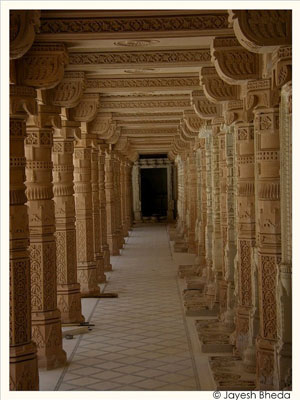
Bhadreshwar was known as Bhadrawati Nagari historically. The ruins of ancient city of Bhadrawati can be found here. The city of Bhadravati has its mentioned in Mahabharata.
Bhadrawati was ruled by King Sidhsen in 449 B.C, who renovated the place. Later it was ruled by The Solanki rulers who were Jains, and they changed the name to Bhadreshwar. Then in 1315, a great famine struck Kutch, after which the town was renovated by Jagdusha, the Jain merchant and philanthropist.A battle that was never fought on 15 December 1815, the army of Kingdom of Kutch was defeated near Bhadreswar, Kutch. As per history the armies of British led by Colonel East and Army of Kutch led by a Muslim commander, Hussain Miya met near Bahdreshwar. The British army was behind the Bhadreswar Jain Temple and temple was coming in between them. Husain Miya respected the sanctity of temple and he didn’t fire on British, fearing temples might be damaged and as such doors were laid open for British Army. The nearest major fortified town of Anjar, Port of Tuna & District of Anjar thus came under British occupation on 25 December 1815. This led to negotiations between rulers of Kutch and British. The Jadeja rulers of Kutch accepted the suzerainty of British in 1818 and Captain James Meckmardo was posted as British Political Resident stationed at Bhuj. The Anjar District, however, remained under direct occupation of British forces for seven years till 25 December 1822, when it was reverted to Rajya Hukumat ( to Princely State of Kutch ) by way on agreement.
Bhadreshwar is popular for its centuries old Jain temple complex known as Vasai Jain Temple. These temple is believed to be one of the oldest Jain temples in India, although they have been renovated and rehabilitated from time to time. It is said a Jain layman named Devchandra laid the foundation stone of this temple centuries ago. The temple was renovated by Shrimalis in the year 1134 and two centuries later in year 1315, they have been renovated by Jagdusha. The temple complex has fifty three shrines, a major central temple and fifty two minor shrines around it, added over many centuries. The temples have been destroyed many times due to natural calamities like earthquakes and the chronicles of Mistris of Kutch, mention that they were the architects and artisans, who renovated temples during the earthquakes of 1819, 1844–45 and 1875.Recently, the temple complex was again completely devastated in earthquake of 26 January 2001, however, it has now been completely rebuilt to as many of the old shrines were destroyed to the extent that it could not be rehabilitated.There is also an ancient Shiva temple known as Chokhanda Mahadev situated at the sea-shore and the big square step well known as the Pandavs Kund said to build by the Pandavas 5000 years ago. This old temple was made with red stones which was also destroyed in 2001 earthquake and has now been completely rebuilt. Besides there are also centuries old Rokadiya Hanuman temple.There is a mosque called Duda Masjid and a stepwell, Duda vaav, in Bhadreshwar, which is very old and which are reliably dated to the late 12th century, meaning they predate the well known Islamic architecture of Ahmedabad by 250 years or so, making them in all likelihood the first mosques built in India.